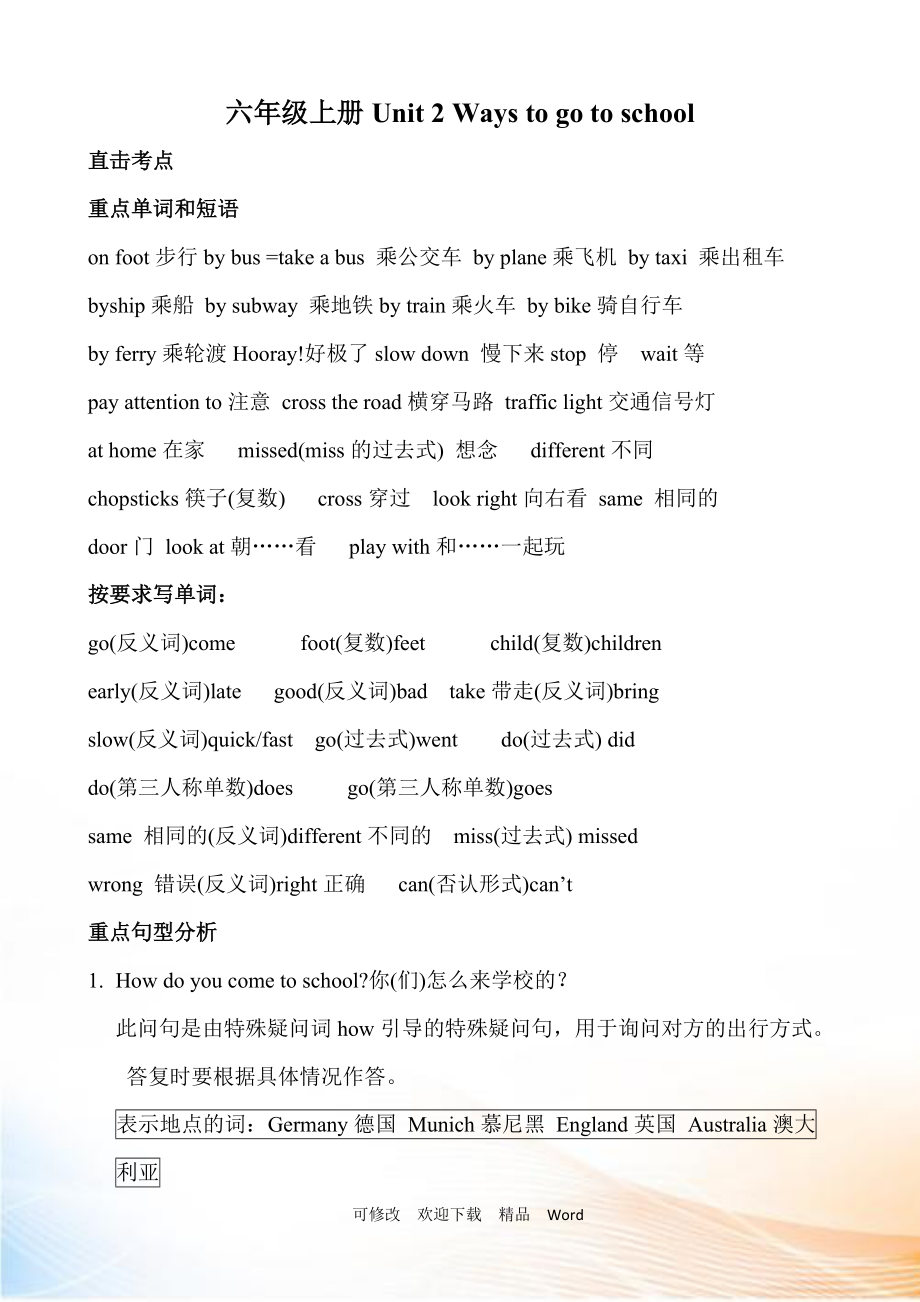《六年級(jí)上冊(cè)Unit 2 Ways to go to school》由會(huì)員分享�,可在線閱讀,更多相關(guān)《六年級(jí)上冊(cè)Unit 2 Ways to go to school(3頁(yè)珍藏版)》請(qǐng)?jiān)谘b配圖網(wǎng)上搜索。
1���、
六年級(jí)上冊(cè)Unit 2 Ways to go to school
直擊考點(diǎn)
重點(diǎn)單詞和短語(yǔ)
on foot步行by bus =take a bus 乘公交車(chē) by plane乘飛機(jī) by taxi 乘出租車(chē)
byship乘船 by subway 乘地鐵by train乘火車(chē) by bike騎自行車(chē)
by ferry乘輪渡Hooray!好極了slow down 慢下來(lái)stop 停 wait等
pay attention to注意 cross the road橫穿馬路 traffic light交通信號(hào)燈
at home在家 missed(miss的過(guò)去式) 想念 d
2��、ifferent不同
chopsticks筷子(復(fù)數(shù)) cross穿過(guò) look right向右看 same 相同的
door門(mén) look at朝……看 play with和……一起玩
按要求寫(xiě)單詞:
go(反義詞)come foot(復(fù)數(shù))feet child(復(fù)數(shù))children
early(反義詞)late good(反義詞)bad take帶走(反義詞)bring
slow(反義詞)quick/fast go(過(guò)去式)went do(過(guò)去式) did
do(第三人稱(chēng)單數(shù))does go(第三人稱(chēng)單數(shù))goes
s
3��、ame 相同的(反義詞)different不同的 miss(過(guò)去式) missed
wrong 錯(cuò)誤(反義詞)right正確 can(否認(rèn)形式)can’t
重點(diǎn)句型分析
1. How do you come to school?你(們)怎么來(lái)學(xué)校的���?
此問(wèn)句是由特殊疑問(wèn)詞how引導(dǎo)的特殊疑問(wèn)句����,用于詢問(wèn)對(duì)方的出行方式�����。 答復(fù)時(shí)要根據(jù)具體情況作答�����。
表示地點(diǎn)的詞:Germany德國(guó) Munich慕尼黑 England英國(guó) Australia澳大利亞
school學(xué)校 the park 公園the cinema電影院 the hospital醫(yī)院 the post office
4、郵局
the bus stop公共汽車(chē)站 home家
2. Usually, I come on foot.=Usually, I walk.通常情況下�,我步行來(lái)。
此句是對(duì)出行方式的答復(fù)句�����。 其中usually意為“通?!保?表示頻率很大�����, on foot意為“步行”�。一般用by表示出行方式。By后面一定要直接加交通工具的單數(shù)形式�,只有“小腳丫”foot與on 搭配��,“步行”用on foot表示���。
3. I must pay attention to the traffic lights.我必須注意交通信號(hào)燈。
must是情態(tài)動(dòng)詞,意為“必須”后面跟動(dòng)詞原形���。
動(dòng)作詞組:
w
5�、ear a helmet戴頭盔 pay attention to the traffic lights注意交通信號(hào)燈
look right向右看
4. Don’t go at the red light!別闖紅燈�����!
此句是Don’t開(kāi)頭的否認(rèn)祈使句, don’t后面跟動(dòng)詞原形���。意為“不要做某事”�。
動(dòng)作詞組:run跑 go at the red light闖紅燈 touch the door觸摸門(mén)
e.g. Don’t smoke.不要吸煙�����。/禁止吸煙���。
Don’t take photos.禁止拍照�。
5 We must look right before crossing the road.我們?cè)跈M穿馬路前必須看看右邊。
此句中must是情態(tài)動(dòng)詞���,意為“必須”后面跟動(dòng)詞原形��,在此句中before是一個(gè)介詞����,而介詞后面跟動(dòng)詞ing形式。
6. There is no door on the bus.公共汽車(chē)上沒(méi)有門(mén)�����。
此句是there be句型的單數(shù)句����,be動(dòng)詞要根據(jù)后面名詞的單復(fù)數(shù)形式來(lái)決定, 名詞為單數(shù)或不可數(shù)名詞就用there is, 名詞為復(fù)數(shù)就用there are.此句中no door意為“沒(méi)有門(mén)”�, 表示單數(shù)含義,因此要用there is開(kāi)頭����。
可修改 歡迎下載 精品 Word
 六年級(jí)上冊(cè)Unit 2 Ways to go to school
六年級(jí)上冊(cè)Unit 2 Ways to go to school

